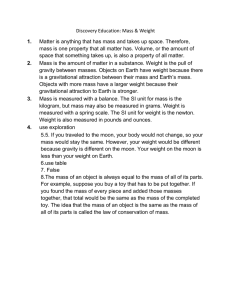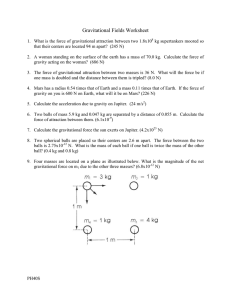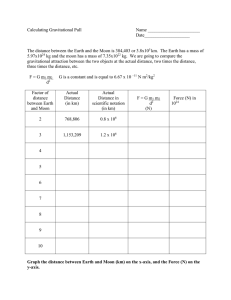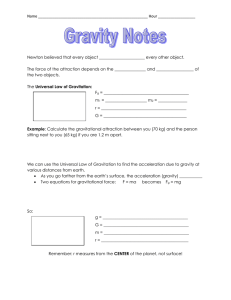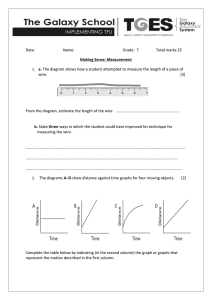Gravitation Physics 1425 Lecture 11 Michael Fowler, UVa
advertisement
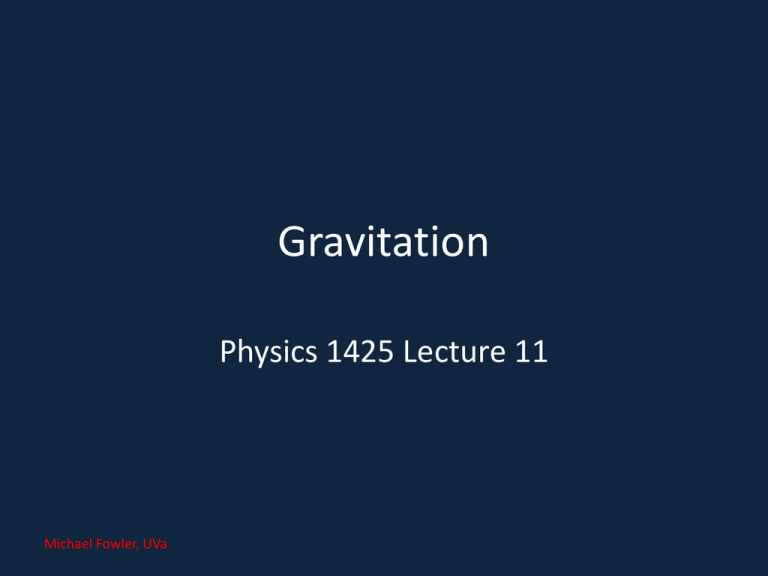
Gravitation Physics 1425 Lecture 11 Michael Fowler, UVa The Inverse Square Law • Newton’s idea: the centripetal force keeping the Moon circling the Earth is the same gravitational force that pulls us to the ground. • BUT: the Moon’s centripetal acceleration is only 1/3600 of g! • The Moon is 60 times further from the Earth’s center than we are. • SO: this suggests the gravitational pull from the Earth decreases with distance from the Earth’s center as 1/r2. Gravitational Attraction is Proportional to Mass • The gravitational force causes everything to fall with the same acceleration: • For downward motion Fgrav = ma = mg • That is, Fgrav/m has the same value for all masses. • Conclusion: F ∝ m: the gravitational force on a mass is proportional to the mass. Clicker Question Does the Moon attract the Earth gravitationally? A. No B. Yes, but with a much weaker force than the Earth attracts the Moon. C. Yes, with the same force the Earth attracts the Moon. So why doesn’t the Earth go round the Moon? • The moon’s mass is about 1% of the Earth’s mass. • In fact, the Moon’s attraction does cause the Earth to go in a circle—both Earth and Moon circle their common center of mass (which is inside the Earth!) We’ll discuss this more later. Gravitational Attraction is Proportional to Both Masses • We’ve already seen, from Galileo’s observation of equal downward acceleration and Newton’s Second Law, that the Earth attracts an object with a force proportional to the object’s mass. • But from Newton’s Third Law, the attractions are equal and opposite—symmetric. • Therefore, the attraction is also proportional to the Earth’s mass. Law of Universal Gravitation • The story so far: • For two masses m1, m2 at a distance r apart, the gravitational attraction between them is proportional to 1/r2 • It is also proportional to both m1 and m2. • Therefore it must have the form m1m2 F =G 2 r where G is some constant. Clicker Question: How could G be determined? A. By accurately measuring the fall of a carefully weighed object B. By observing the satellites of Jupiter C. From calculations based on measuring relative planetary motions in the Solar System D. It can’t be determined in any of these ways without some further information Measuring G • G was first measured in 1798 by a wealthy English aristocrat, Cavendish. It was a very expensive experiment—the apparatus is ten feet high, in its own constructed room. He measured a 10-7 Newton attraction between lead balls. http://www.youtube.com/watch?v=vWlCm0X0QC0 http://www.youtube.com/watch?v=EE9TMwXnx-s&NR=1 Weighing the Earth • Cavendish called his experiment “weighing the Earth”: he knew the inverse square law, the big balls had masses of about 150 kg, and were about 0.25 meters away from the small balls. • Comparing the attraction of the small balls to the big balls with the small balls’ attraction to the Earth (the ratio was about 10-8) and allowing for the different r’s (ratio about 3x106) he found the mass of the Earth to be 6x1024 kg, with about a 2% error from the known modern value. The value of G is 6.67x10-11. Cavendish ‘s measurements give G = 6.75x10-11. Weighing the Sun… • Once we know G, we can find the mass of the Sun. • Taking the Earth’s orbit around the Sun to be a circle, the Sun’s gravity providing the centripetal force, F = ma is mv 2 GMm = 2 r r simplifying to GM = v 2 r. Putting in v = 30 km/sec , r = 150x106 km, G =6.7x10-11, we find M = 2x1030 kg. Weighing a Galaxy… • We can estimate the mass of a galaxy by measuring the centripetal acceleration of an outer star. We can also estimate it by just counting stars—but the mass turns out to be much greater that the total mass of visible stars. Most of the mass is dark matter. http://geology.com/nasa/nasa-universe-pictures.shtml Vector Form of Gravitational Force • The gravitational force is of course a vector, the attraction of sphere B on sphere A points from the center of A towards that of B, GmAmB FAB = rˆAB 2 rAB where rˆAB is a unit vector • A A B C pointing from A to B. • The total force on A is = FA FAB + FAC . Massive Spherical Shell • Imagine a massive hollow uniform spherical shell. • The gravitational force is the sum of the attractive forces from all parts of the shell. • Inside the shell, this force is zero everywhere! Smaller closer areas balance larger more distant areas. • Outside the shell, Newton proved the force was the same as if all the mass were at the center. • A Clicker Question How will g change (if at all) on going from the Earth’s surface to the bottom of a deep mine? A. g will be a bit stronger at the bottom of the mine B. It will be weaker C. It will be the same as at the surface Kepler’s First Law Each planet moves in an elliptical orbit with the Sun at one focus • He deduced this from analyzing many observations. • An ellipse is the set of points P such that PF1 +PF2 is constant, the points F1 and F2 are the foci, PF1 means the distance from point P to point F1. • A F1 P F2 You can draw an ellipse by fixing the ends of a piece of string at A, B then, keeping the string tight, loop it around a pencil point at P and move the pencil around on paper. About Ellipses… • The standard notation is to label the two foci F1, F2. (The term “focus” is used because if a light is placed at F1, and the ellipse is a mirror, the reflected light all goes to F2.) • The eccentricity e of the ellipse is how far a focus is from the center C compared with the furthest point of the ellipse. • e = 0 means a circle: most planetary orbits are close to circles—for Earth, e = 0.017. 2b • A F1 ea C P 2a F2 2a is the length of the “major axis”, 2b the length of the “minor axis” a is called the semimajor axis length. Kepler’s Second Law As the planet moves, a line from the planet to the center of the Sun sweeps out equal areas in equal times. • Clicker Question: • The Earth is moving fastest in its orbit when: A. It is closest to the Sun B. When it’s furthest from the Sun C. Cannot be determined from this Law. • A Sun Animation! P Clicker Question When is Earth closest to the Sun? A. B. C. D. January June July August Kepler’s Third Law • Calling the average distance of a planet from the Sun r, and the time for one complete orbit T, then • T2/r3 is the same number for all the Sun’s planets. • We can prove this for circular orbits (a good approximation): F = ma is GMm / r 2 = mv 2 / r , and putting in v = 2πr/T gives T 4π = 3 r GM Sun 2 2 the same value for all the Sun’s planets! Trip to Mars • The only practical route to Mars is an ellipse taking initial full advantage of the Earth’s own orbital speed, and just getting out far enough to touch Mars’ orbit. Timing is crucial. • Try it here. • a The Slingshot • The only way to really get out there is to use the planets themselves to bump you up to higher speed … well, pull you up. • To see how Jupiter is used to get spacecraft further out, check the slingshot animation. Clicker Question: dropping an iPod! An iPod has a built-in accelerometer, which gives a continuous reading of gravity. Just resting on a table, it reads g. If I drop it, what does it read while falling? A. B. C. D. Zero. g. Less than g, but not zero. More than g. Weightlessness in Orbit • We don’t directly feel gravity, we feel the compression of parts of our bodies, perhaps stretching of other parts, supporting us. • The gravitational force on a body is just as strong in a freely falling elevator—but we don’t feel it. • An orbiting spacecraft is in freefall, just like the elevator, so things in it are “weightless” in the same way. Footnote: Galileo already knew this… • He was asked: if a large stone is falling with a small stone on top of it, does the small stone press on the large one? • His reply: One always feels the pressure upon his shoulders when he prevents the motion of a load resting upon him; but if one descends just as rapidly as the load would fall how can it press upon him? Do you not see that this would be the same as trying to strike a man with a lance when he is running away from you with a speed which is equal to, or even greater, than that with which you are following him? • You must therefore conclude that, during free and natural fall, the small stone does not press upon the larger and consequently does not increase its weight as it does when at rest.
